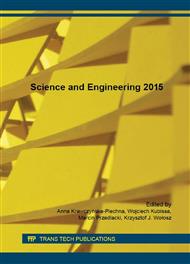p.192
p.202
p.210
p.219
p.225
p.231
p.238
p.246
p.255
Numerical Simulation of Subsoil Freezing Risk under the Freezer Room
Abstract:
The article deals with risks of subsoil freezing which lead to volumetric changes of frozen water contained in the soil. These changes can cause damage of foundations of building objects. The issue was solved by steady-state and transient 1D and 2D numerical simulations of heat conduction in the floor and subsoil under a freezer room. These simulations were performed in software CalA. Several possibilities of operating conditions of the freezer room were examined within different boundary conditions. Impact of different simulation setups on subsoil temperature fields was observed. Use of exhaust heat from condenser of a freezing system is suitable method for thermal activation of the floor structure. This solution eliminates risks of subsoil freezing more economically than commonly used electrical heating cables.
Info:
Periodical:
Pages:
225-230
Citation:
Online since:
November 2015
Authors:
Price:
Сopyright:
© 2015 Trans Tech Publications Ltd. All Rights Reserved
Share:
Citation:


